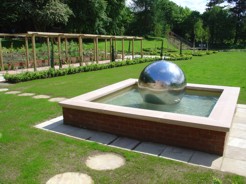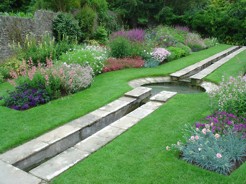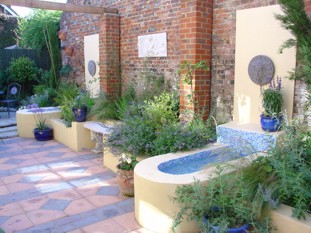Water Features in Gardens
It is perhaps this memory of wanting to interact with water which makes us yearn to have it in our gardens.
Water of course is not only fundamental to life but also appears as a key design element in gardens throughout the world, from the cool courtyards of Italy to the Peterhof Gardens in Russia with their beautifully stunning gold statues and cascading waterfalls.
Water plays with your senses, providing a point of interest or place for a sculptural art object (see featured silver ball). Whilst not everyone is lucky enough to have a river running through their garden, there are other options for introducing water into even the smallest of outdoor spaces.
The Water element features heavily in most gardens that I’m asked to design and build. Waterfalls, ponds, streams, fountains, cascades, rills and horizon pools (pools which are designed to appear to touch the horizon) are just some of the ways that water can soothe the ear and catch the eye.
Choice of type depends upon the size and surroundings, placement and design specifics of your outdoor space. Are you looking to provide a focal point or a hidden natural environment for wildlife? It’s important to work out what you want your feature to do for your garden and how it will look through the four seasons.
Feature
Although there are no hard and fast rules, I generally regard ponds as having wildlife of some description and pools as being architectural areas of water in their own right. The image shown to all intents and purposes is a pool – all be it a rather grand one!
Small courtyards are perfect for elegant water features as they cool the air temperature. Small pools like the one in the Italianate courtyard (see photo) can be finished with delicate detailing like mosaic tiles which lend the courtyard a distinctive character.



Elements
When planning where to place water within a garden there are a few key points well worth remembering. Firstly, wildlife ponds are generally better off when accompanied by some shade for the creatures living in it. However, small ponds can easily get choked by falling leaves so place away from large trees.
Deep water can be hazardous for small children so keep depth to sensible limits and place within eyesight of the house for peace of mind.
If you’re introducing fountains or pumps you’ll need a power supply which should be fitted by a qualified electrician. It’s also worth considering ‘lighting’ at the design planning stage. When lit at night, a water feature can provides an atmospheric space in which to chill out with friends.
Planting
For wildlife ponds you’ll need to plan the edges of the pond, ensuring you have a shallow gradient for part of the perimeter for migrating insects and frogs and don’t forget shelving for aquatic plants which provide the wildlife with not only food but a safe havens for breeding.
As a vital element of any wildlife pond, planting also helps with the water quality. Oxygenating plants like Water Violet and Hornwort help to keep water clear of algal growth.
Materials
The relaxing sounds of water tinkling across stone can soothe even the hardest day. Water features can be constructed from a wide variety of materials in sympathy with the rest of the property, from natural stone, to brick or even glass or stainless steel – which reflect the light on the water beautifully. In a rural setting large rocks and stonework can lend a water feature a fantastic backdrop.
The Senses
Drinking from a fountain on a summer’s day, feeling the pleasure of feet dipped in a stream or simply listening to the sound of water cascading over rocks, water catches our senses and leaves us with memories, an ever important element of a well design garden.